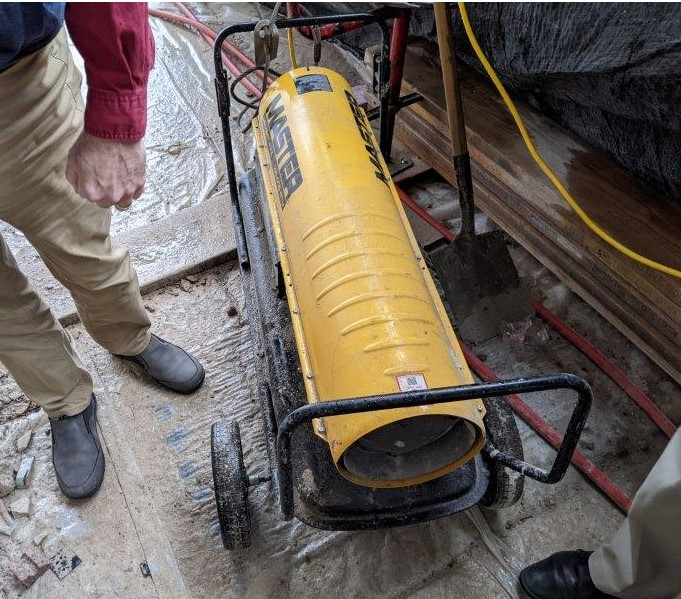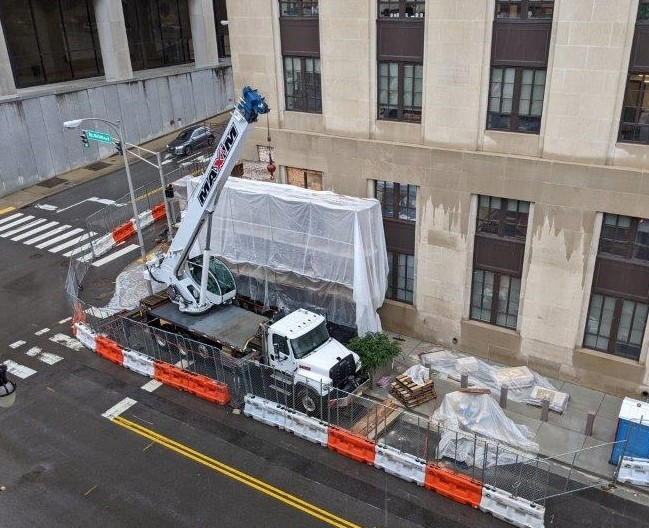|
I require information about stack bond brick walls when used in brick veneer wall systems with stud wall back up and outboard mineral wool insulation Brick veneer not laid in running bond is not discussed in the TMS 402/602 Building Code Requirements and Specifications for Masonry Structures. The most information available is on the Brick Industry Association website.
Specific to the installation, BIA recommends reinforcing the veneer with at least one wire embedded in bed joints. This is because stack bond has no in-plane or out of plane structural value. Make sure you use the proper veneer anchor system also. Wall ties are only allowed with wood stud backup. Veneer anchors are required with steel stud or masonry backup. Use brick with the least amount of variation in unit size. The alignment of the units follows the centerline of the head joints. The tolerance for the variation in length for a modular size FBX brick given in ASTM C216 is +/- 5/32". The variation in straight and plumb within the same parameters. All of this information must be written in the specification and a mockup should be required as well. Call me if you need to. Be safe. Jerry Painter, FASTM, CGC, SMC 352-494-8955
1 Comment
I attended a webinar which you were a part of a month or so ago. A product was mentioned for the cleaning of efflorescence. One of our clients is in need of this product, can you please send me more information? Efflorescence is a word used by many to cover a myriad of different but related issues. We used ProSoCo products for our masonry cleaning needs for over 50 years. I sent the New York rep for ProSoCo your contact info for him to contact you directly. There are several clarifications that are needed to select the correct material to clean your client's masonry. For instance, we need to know if the material is brick, block, stone, etc. We will need to know if it is new building bloom, efflorescence, or maybe white scum. Age of the masonry can be important. As you know there are 2 key elements to this issue. Those being insoluble salts and moisture. The whole thing could be a moisture problem. No matter the outcome, keep me posted on how things are going.
Be safe. Jerry Painter, FASTM Block, and the base materials that block are made of, must meet all of the requirements of ASTM C90. That is pretty much all there is to it. C90 references all of the other ASTM Standards that tie in so C90 is your starting point. All the ASTMs regarding block are contained in Volume 4.05 which you can get free when you join ASTM (if you are not already a member).
Feel free to ask questions as you go through the standards governing block. We have a two day workshop, which HEAVILY covers all of the governing ASTM standards, coming up on May 20th and 21st (Friday and Saturday). Our presenters are the most knowledgeable professionals in Florida on this very subject. More information on the workshop is available on www.masonryworkshop.com The contractor wants to use a split face unit for the single wythe load-bearing walls of a small building with two ADA restrooms and a small storage room for a private park. The building will be ventilated only. My concern is moisture intrusion into the interior spaces. The walls are not insulated. Will a waterproofing coating at the exterior and the use of a waterproofing additive to the mortar keep water out of the wall system? Is there an additive that can be added during the mixing and forming of the wall units? Some think that a single-wythe CMU wall cannot be effectively built to repel moisture. It can. I am attaching a NCMA TEK that can be very helpful. Water repellant is typically put into architectural CMU as a standard procedure especially if the units are colored. You MUST add the repellant to the mortar also. When this is done and you add a compatible flashing at the base of the wall. you should have the wall you are trying to get. If you want to stain or paint the wall I would suggest an elastomeric coating as it will bridge any small voids. You should contact Lisa Pelham (813-255-4737) @ Oldcastle or Daryl Gorenflo (407-280-1487) @ A-1 Block. Either are more than willing to help you, TIf I can also help I'm in Gainesville. Call me. Be safe.
Jerry Painter, FASTM,CGC, SMC 352-494-8955 It is our understanding that the current best practices for Central Florida residential subcontractors is to install inspection holes at filled cell locations, and not perform consolidation of grout. Is this allowed by the code? Also, what is the standard method of determining if all of the cells were completely filled with grout? MAF Response (Jerry Painter):
The inspection holes are to make sure the base of the CMU cell is clear and that the masonry grout reaches the bottom. The requirement for consolidation and re-consolidation is not forgiven any where in the structural masonry code, TMS 402/602. Sounding is one way to determine solidity. I feel a lot more comfortable with thermal photography if you can achieve the temperature differential and access to the wall. The MAF has a Structural Masonry Workshop we do 4 times a year. Last year we did 2 in Broward County for their Building Officials, Plans Analysts and others. Maybe we need to do a better job in Central Florida of reaching Code officials. MAF Response (Don Beers): I just wanted to concur with Jerry on the requirement for consolidation and reconsolidation in both commercial and residential construction built in accordance with the Florida Building Code. The code requires a minimum 3"x3" cleanout for all wall over 5'-4" in height but, as Jerry pointed out, this requirement has nothing to do with consolidation of the grout once it is in place. The problem with residential construction is there is usually no inspection on the job during grout placement so the inspector uses the cleanout as a means of determining that the cell was completely filled with grout. Unfortunately, just because the cell is filled at the bottom does not mean that the cell is filled all the way up with no void areas. Careful sounding of all grouted areas of the wall is a standard method of determining whether void areas are present in the cell, however, again as Jerry pointed out, thermal imaging is a more accurate and preferable method. I would also recommend a review of the delivery tickets for slump and times to determine if a potential problem is obvious. The grout should have been fluid (8" to 11" slump) and placed within 90 minutes of batching. This might help inform you as to the method used to determine whether all cells are completely filled. Might someone there be able to help me locate information, maybe in the Building Code Requirements and Specifications for Masonry Structures as to the placement of CJ's in 4" cmu on 6" cmu knee walls? The architect we are working with cites the National Concrete Masonry Institute as requiring CJ placement/location at a length to height ration of 1.5 to 1 so we are expected to put CJ's every 6'. This doesn't make sense to me, 25+ years in the biz and this is a first for this situation. Hoping the MSJC has provided some direction other than the NCMI? While the location of control joints is required in concrete masonry work TMS 402/602 do not discuss the location and design of them. NCMA is the resource for that information. There are several reasons for properly locating and installing these control joints. There are a couple of ways of determining locations. One is the use of engineering to determine the spacing and size of the control joints. This is the responsibility of the project engineer. This method uses the coefficient of shrinkage and other aspects of the cmu to determine the size and location. The other method is the empirical method which is described in NCMA TEK 10-02D. Table 1 in this TEK shows a 1.5 height X length as the location. But with shorter walls of less than +/- 16' a maximum of 25'-0" is recommended. If your designer does not locate the joints I would recommend using a 22-24'-0" spacings per Table 1. I am attaching other Tek Notes for you to use or pass on to the project engineer. Since you have a 4" cmu veneer I am including NCMA TEK 10 04 for veneers. I hope this works for you. If you need to discuss this further please call me.
Be Safe and RAISE the LINE. Jerry Painter, FASTM Additional Information: NCMA TEK 10-02D NCMA TEK 10 04 I have not been able to find any references to any chemical reaction to fresh or curing mortar being discolored by or reacting to diesel fumes. I am not considering heavy black exhaust smoke from trucks or buses. What I am concerned about is the life safety issue of the effect of the exhaust on the workers. When fossil fuel burns it creates carbon monoxide (CO). It must be well-ventilated, and I don't see any ventilation equipment in your photo. The greatest impact that the heated work area will cause is the reduction in humidity. This will impact the setting time of the mortar, the need for retempering the mortar, and the tooling time of the mortar. Each one of those can cause variations in the color of the joints. If you use steam heat to offset the dryness you could cause ice to form on or about the enclosure. I believe a review of cold weather construction and CFR 1910 and 1926 requirements for handling exhaust and enclosures would be a minimum requirement to provide good life safety and quality masonry work. I hope we've been able to help. Call me if you see the need.
Be safe. Jerry Painter, FASTM Are control joints required in CMU structural backup walls in double wythe cavity systems with brick veneer on the exterior, drywall on the interior and a drainage plane between the two wythes? Quote from the Control Joint section of NCMA TEK 10-01A - “Because shrinkage cracks in concrete masonry are an aesthetic rather than a structural concern, control joints are typically only required in walls where shrinkage cracking may detract from the appearance or where water penetration
may occur.” Control joints in the CMU wall are there to accommodate movement of the wall due primarily to shrinkage of the concrete block. Uncontrolled cracking, when visible, is unsightly and when exposed to wind driven rain may allow water to enter the wall and possibly the interior of the building. The control joints both hide the cracking for aesthetic reasons and concentrates the movement in a location (the control joint) where waterproofing can be easily applied to prevent water from entering through the joint into the structure. Double wythe cavity walls containing a drainage plane between the two wythes offer the unique feature of both visually covering the CMU backup wall and preventing wind driven rain from reaching the backup wall. As stated in TEK 10-01A this eliminates the two main reasons for incorporating control joints into the structural backup CMU wall. In making the determination to eliminate control joints in the structural masonry backup of a double wythe cavity wall it is important to ensure that the section of wall will indeed be neither visible or subject to exterior weather. Particularly in long sections of wall, the elimination of control joints in a single area of the wall may produce additional stress, and thus larger more pronounced cracks, in an adjacent section of the wall exposed to visual sight or weather. Control joints may also have a structural purpose, thus elimination should not be done without the knowledge of the structural engineer for the project. I am building a new 3600 sq ft(a/c) single story house in Palm Beach Country Estates, Palm Beach 33418. The lot is just West of the Turnpike and I95 ( approximately ten miles inland from the ocean). My Architect has asked if I want to use a bond beam or a tie beam as I am building further inland. I have always built with tie beams but those structures were East of I95 and closer to the ocean. The concern is obviously structural strength and roof security in relation to hurricanes. I am aware of the structural advantage of a tie beam but how do bond beams compare? What do you see as the cost advantage? Are there any design specifications that should be included? Yes, the formed and poured concrete tie beam is stronger. Do you need the extra strength and is it worth the money? I say NO and NO. Masonry bond beams can be designed to meet all loadings and wind speeds. A standard South Florida bond beam is going to have 2-#5 or 1-#7 bar in the top course with the top two courses grouted solid. The bottom grouted course would need to be reinforced over all openings and the amount of reinforcement would depend on the roof load and span of opening. The new ICC 600 give direct guidance and I would suggest you secure a copy to have all the latest design information for south Florida wind loads.
It is also available online for viewing at https://codes.iccsafe.org/content/ICC6002020P1 All other reinforcement is approximately the same. As far as cost difference, your local builder is going to have to give you that info. Most So Fla contractors are intimately familiar with both types of construction. The most important items are that your bond beam (either one) is solidly hooked down to your wall at the spacing of your wall steel and that your bond beam (either one) is laterally supported by the roof system, particularly at the gable end (if there is one). I recommend a hip roof that supports your bond beam or tie beam at the entire length. I have viewed a LOT of hurricane damage and have not seen a properly designed masonry bond beam that failed OTHER THAN a failure of an single course 8” deep bond beam. I do not recommend 8” masonry bond beams (or 8” poured tie beams!). There is not enough embedment for the vertical hook to develop into the beam. Don Beers, PE, GC 561-310-9902 [email protected] How do you control the grounds (stucco thickness without casing) Additionally, do you need casing to separate dissembler materials? There is nothing in the code that prevents you from putting in additional casing and control joints. The misconception that we wanted to dispel is that control joints are “required” by the code in direct applied stucco at locations other than where you find control joints in the substrate. I would reinforce the potential leakage problem inherent with all installed stucco joints. Proper detailing of joints is essential for a leak proof stucco coating. As you mentioned there should be a joint at dissimilar materials.
|
Authors:

Categories
All
Archives
May 2024
|
Masonry Resources |
MAF Websites |
Masonry Association of Florida, Inc. |PO Box 24474 , Fort Lauderdale, FL 33307
Copyright © 2017. All Rights Reserved.
Sitemap
Sitemap



 RSS Feed
RSS Feed
